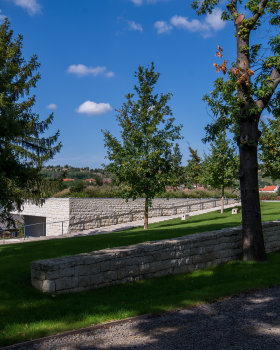查看完整案例


收藏

下载
© Ahmad Mirzaee
C.Ahmad Mirzaee
架构师提供的文本描述。客户要求我们设计一座清真寺,最大限度地容纳祈祷者在旧址祈祷大厅的区域,周围是70年的老树和医院的主要街道。最初的想法是在四个挑战上形成的:最大限度的祈祷能力,保护树木,靠近人行道的主轴和旧的祈祷大厅。在第一步中,考虑到工程条件,选择了一种没有庭院的清真寺模式,将整个树木之间的区域作为设计区域。考虑到古老的祈祷大厅作为遗址历史的一部分,它的阴谋计划形成了新清真寺的穹顶计划。
Text description provided by the architects. The client asked us to design a mosque with the maximum capacity for prayers in the area of the old prayer hall at the site, being surrounded by 70-year-old trees and the hospital’s main streets. The primary idea was formed on four challenges; the maximum capacity for prayers, preserving the trees, proximity to the main axis of the pavement and the old prayer hall. In the first step, considering the project conditions, the pattern of a mosque without court was chosen where the whole area between the trees was regarded as the designing area. Considering the oldness of the prayer hall as part of the site’s history, its plot plan formed the plan of the new mosque’s dome.
关于赞助人的进入,为清真寺设计了两个条目,这两个条目由Riwagh的链接元素连接在一起,传统上被认为是设计波斯清真寺的一个重要因素。除了创造视觉交流之外,Riwagh的开放墙还组织了清真寺与北部拥挤通道的联系。在入口旁边,两个尖塔被设计成一个旋转的结构。这些尖塔为邀请进入清真寺和清真寺的象征图标做出了贡献,这是圆顶两侧的两座尖塔。然而,当你在建筑物周围移动时,这个图像会发生变化,使观察者的视野多样化。
Regarding the access of Patrons, two entries were designed for the mosque.The two entries are connected together by the linking element of Riwagh, which is traditionally considered as an important element in designing Persian mosques. In addition to creating Visual communication, the openwork wall of Riwagh organizes the association of mosque with the northern crowded passage. Beside the entries, two minarets have been designed in a rotating configuration. The minarets have contributed to the invitation of the entries and the symbolicicons of the mosque, two minarets on both sides of the dome. Nevertheless, this image would change as you move around the building, diversifying the observer’s vision.
© Ahmad Mirzaee
C.Ahmad Mirzaee
当他们进入清真寺时,祈祷者将从一个开放的空间传递到一个半开放的空间,这是伊朗传统建筑中常见的模式。这种形式允许我们在天空的南半球打开一个孔,这样太阳一年到头都在正午的时候照射穹顶。清真寺的正面覆盖着石头,在现场的树木中展示了一张厚重、结实和简单的面孔,与铜涂层形成了适当的对比。形式、材料和几何学的简单性,以及历史清真寺的空间模式和传统细节,如开敞墙和室内铭文,代表了设计清真寺的一般做法,即在建造清真寺时注意伊斯兰传统,并以现代语言表达。
The prayers would pass from an open space towards a semi-open space as they enter the mosque which is a common pattern in Iran’s traditional architecture. This form allows us to open an orifice against the southern half of the sky so that the sun irradiate the dome through it at noon time all year round. The facade of the mosque is covered with stone to demonstrate a heavy, strong, and simple face among the trees at the site creating an appropriate contrast in association with the copper coating. The simplicity of the form, material and geometry along with employing spatial patterns of historic mosques and traditional details such as openwork walls and indoor epigraphs represents the general approach in designing the mosque, i.e. paying attention to Islamic traditions in building mosques and expressing it by the modern language.
Architects Paya Payrang Architectural Group
Location Shiraz, Fars Province, Iran
Architects in Charge Ashkan Qashqai, Samaneh Motaghipishe, Pouya Ranjbar
Area 2750.0 m2
Project Year 2016
Photographs Ahmad Mirzaee, Samaneh Motaghipishe
Category Mosque
Manufacturers Loading...





































